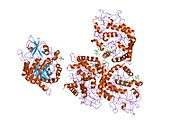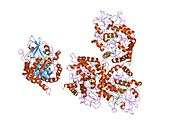CHI3L1
Chitinase-3-like protein 1 (CHI3L1), also known as YKL-40, is a secreted glycoprotein that is approximately 40kDa in size that in humans is encoded by the CHI3L1 gene.[5][6][7] The name YKL-40 is derived from the three N-terminal amino acids present on the secreted form and its molecular mass. YKL-40 is expressed and secreted by various cell-types including macrophages, chondrocytes, fibroblast-like synovial cells, vascular smooth muscle cells, and hepatic stellate cells. The biological function of YKL-40 is unclear. It is not known to have a specific receptor. Its pattern of expression is associated with pathogenic processes related to inflammation, extracellular tissue remodeling, fibrosis and solid carcinomas[8] and asthma.[9]
Function
Chitinases catalyze the hydrolysis of chitin, which is an abundant glycopolymer found in insect exoskeletons and fungal cell walls. The glycoside hydrolase 18 family of chitinases includes eight human family members. This gene encodes a glycoprotein member of the glycosyl hydrolase 18 family. The protein lacks chitinase activity and is secreted by activated macrophages, chondrocytes, neutrophils and synovial cells. The protein is thought to play a role in the process of inflammation and tissue remodeling.[7] YKL-40 lacks chitinase activity due to mutations within the active site (conserved sequence: DXXDXDXE ; YKL-40 sequence: DGLDLAWL).[8]
Regulation and mechanism
YKL-40 has been linked to activation of the AKT pro-survival (anti-apoptotic) signaling pathway. YKL-40 promotes angiogenesis through VEGF-dependent and independent pathways.[10]
YKL-40 is a migration factor for primary astrocytes and its expression is controlled by NFI-X3, STAT3, and AP-1.[11]
CHI3l1 is induced by a variety of cancers and in the presence of semaphorin 7A (protein) can inhibit multiple anti-tumor immune system responses. Activating an antiviral immune pathway known as the RIG-like helicase (RLH) has the ability to counter CHI3l1 induction. Cancer cells can offset RLH by stimulating NLRX1. Poly(I:C), an RNA-like molecule, can stimulate RLH activation. RLH activation can also inhibit the expression of receptor IL-13Rα2pand lmonary metastasisre. It stores NK cell accumulation and activation. It augments the expression of IFN-α/β, chemerin and its receptor ChemR23, p-cofilin, LIMK2 and PTEN and inhibiting BRAF and NLRX1 in a MAVS-dependent manner.[12]
Cancer
It is assumed that YKL-40 plays a role in cancer cell proliferation, survival, invasiveness and in the regulation of cell-matrix interactions. It is suggested that YKL-40 is a marker associated with a poorer clinical outcome in genetically defined subgroups of different tumors. YKL-40 was recently introduced into (restricted) clinical practice. A few techniques are available for its detection.[8]
YKL-40 is a Th2 promoting cytokine that is present at high levels in the tumor microenvironment and in the serum of cancer patients.[13][14] Elevated levels of YKL-40 correlate strongly with stage and outcome of various types of cancer, which establish YKL-40 as a biomarker of disease severity.[15] Targeting YKL-40 with neutralizing antibodies is effective as a treatment in animal models of glioblastoma multiforme.[16]
YKL-40 also enhances tumor survival in response to gamma-irradiation.[10]
References
- 1 2 3 GRCh38: Ensembl release 89: ENSG00000133048 - Ensembl, May 2017
- 1 2 3 GRCm38: Ensembl release 89: ENSMUSG00000064246 - Ensembl, May 2017
- ↑ "Human PubMed Reference:".
- ↑ "Mouse PubMed Reference:".
- ↑ Hakala BE, White C, Recklies AD (December 1993). "Human cartilage gp-39, a major secretory product of articular chondrocytes and synovial cells, is a mammalian member of a chitinase protein family". The Journal of Biological Chemistry. 268 (34): 25803–10. PMID 8245017.
- ↑ Rehli M, Krause SW, Andreesen R (July 1997). "Molecular characterization of the gene for human cartilage gp-39 (CHI3L1), a member of the chitinase protein family and marker for late stages of macrophage differentiation". Genomics. 43 (2): 221–5. doi:10.1006/geno.1997.4778. PMID 9244440.
- 1 2 "Entrez Gene: CHI3L1 chitinase 3-like 1 (cartilage glycoprotein-39)".
- 1 2 3 Kazakova MH, Sarafian VS (2009-03-01). "YKL-40--a novel biomarker in clinical practice?". Folia Medica. 51 (1): 5–14. PMID 19437893.
- ↑ Ober C, Tan Z, Sun Y, Possick JD, Pan L, Nicolae R, Radford S, Parry RR, Heinzmann A, Deichmann KA, Lester LA, Gern JE, Lemanske RF, Nicolae DL, Elias JA, Chupp GL (April 2008). "Effect of variation in CHI3L1 on serum YKL-40 level, risk of asthma, and lung function". The New England Journal of Medicine. 358 (16): 1682–91. doi:10.1056/NEJMoa0708801. PMC 2629486. PMID 18403759.
- 1 2 Francescone RA, Scully S, Faibish M, Taylor SL, Oh D, Moral L, Yan W, Bentley B, Shao R (April 2011). "Role of YKL-40 in the angiogenesis, radioresistance, and progression of glioblastoma". J. Biol. Chem. 286 (17): 15332–43. doi:10.1074/jbc.M110.212514. PMC 3083166. PMID 21385870.
- ↑ Singh SK, Bhardwaj R, Wilczynska KM, Dumur CI, Kordula T (November 2011). "A complex of nuclear factor I-X3 and STAT3 regulates astrocyte and glioma migration through the secreted glycoprotein YKL-40". J. Biol. Chem. 286 (46): 39893–903. doi:10.1074/jbc.M111.257451. PMC 3220556. PMID 21953450.
- ↑ Ma B, Herzog EL, Moore M, Lee CM, Na SH, Lee CG, Elias JA (2016-05-20). "RIG-like Helicase Regulation of Chitinase 3-like 1 Axis and Pulmonary Metastasis". Scientific Reports. 6: 26299. doi:10.1038/srep26299. PMC 4873814. PMID 27198666.
- ↑ Høgdall EV, Ringsholt M, Høgdall CK, Christensen IJ, Johansen JS, Kjaer SK, Blaakaer J, Ostenfeld-Møller L, Price PA, Christensen LH (2009). "YKL-40 tissue expression and plasma levels in patients with ovarian cancer". BMC Cancer. 9: 8. doi:10.1186/1471-2407-9-8. PMC 2645422. PMID 19134206.
- ↑ Bernardi D, Padoan A, Ballin A, Sartori M, Manara R, Scienza R, Plebani M, Della Puppa A (April 2012). "Serum YKL-40 following resection for cerebral glioblastoma". J. Neurooncol. 107 (2): 299–305. doi:10.1007/s11060-011-0762-7. PMID 22102082.
- ↑ Johansen JS, Christensen IJ, Riisbro R, Greenall M, Han C, Price PA, Smith K, Brünner N, Harris AL (July 2003). "High serum YKL-40 levels in patients with primary breast cancer is related to short recurrence free survival". Breast Cancer Res. Treat. 80 (1): 15–21. doi:10.1023/A:1024431000710. PMID 12889595.
- ↑ Faibish M, Francescone R, Bentley B, Yan W, Shao R (May 2011). "A YKL-40-neutralizing antibody blocks tumor angiogenesis and progression: a potential therapeutic agent in cancers". Mol. Cancer Ther. 10 (5): 742–51. doi:10.1158/1535-7163.MCT-10-0868. PMC 3091949. PMID 21357475.
External links
- Human CHI3L1 genome location and CHI3L1 gene details page in the UCSC Genome Browser.
Further reading
- Rathcke CN, Vestergaard H (2007). "YKL-40, a new inflammatory marker with relation to insulin resistance and with a role in endothelial dysfunction and atherosclerosis". Inflamm. Res. 55 (6): 221–7. doi:10.1007/s00011-006-0076-y. PMID 16955240.
- Nyirkos P, Golds EE (1990). "Human synovial cells secrete a 39 kDa protein similar to a bovine mammary protein expressed during the non-lactating period". Biochem. J. 269 (1): 265–8. PMC 1131563. PMID 2375755.
- Maruyama K, Sugano S (1994). "Oligo-capping: a simple method to replace the cap structure of eukaryotic mRNAs with oligoribonucleotides". Gene. 138 (1–2): 171–4. doi:10.1016/0378-1119(94)90802-8. PMID 8125298.
- Suzuki Y, Yoshitomo-Nakagawa K, Maruyama K, et al. (1997). "Construction and characterization of a full length-enriched and a 5'-end-enriched cDNA library". Gene. 200 (1–2): 149–56. doi:10.1016/S0378-1119(97)00411-3. PMID 9373149.
- Kirkpatrick RB, Emery JG, Connor JR, et al. (1998). "Induction and expression of human cartilage glycoprotein 39 in rheumatoid inflammatory and peripheral blood monocyte-derived macrophages". Exp. Cell Res. 237 (1): 46–54. doi:10.1006/excr.1997.3764. PMID 9417865.
- Renkema GH, Boot RG, Au FL, et al. (1998). "Chitotriosidase, a chitinase, and the 39-kDa human cartilage glycoprotein, a chitin-binding lectin, are homologues of family 18 glycosyl hydrolases secreted by human macrophages". Eur. J. Biochem. 251 (1–2): 504–9. doi:10.1046/j.1432-1327.1998.2510504.x. PMID 9492324.
- Johansen JS, Stoltenberg M, Hansen M, et al. (1999). "Serum YKL-40 concentrations in patients with rheumatoid arthritis: relation to disease activity". Rheumatology (Oxford). 38 (7): 618–26. doi:10.1093/rheumatology/38.7.618. PMID 10461474.
- Nordenbaek C, Johansen JS, Junker P, et al. (1999). "YKL-40, a matrix protein of specific granules in neutrophils, is elevated in serum of patients with community-acquired pneumonia requiring hospitalization". J. Infect. Dis. 180 (5): 1722–6. doi:10.1086/315050. PMID 10515841.
- Connor JR, Dodds RA, Emery JG, et al. (2000). "Human cartilage glycoprotein 39 (HC gp-39) mRNA expression in adult and fetal chondrocytes, osteoblasts and osteocytes by in-situ hybridization". Osteoarthr. Cartil. 8 (2): 87–95. doi:10.1053/joca.1999.0276. PMID 10772238.
- Østergaard C, Johansen JS, Benfield T, et al. (2002). "YKL-40 is elevated in cerebrospinal fluid from patients with purulent meningitis". Clin. Diagn. Lab. Immunol. 9 (3): 598–604. doi:10.1128/CDLI.9.3.598-604.2002. PMC 119997. PMID 11986266.
- Kronborg G, Ostergaard C, Weis N, et al. (2003). "Serum level of YKL-40 is elevated in patients with Streptococcus pneumoniae bacteremia and is associated with the outcome of the disease". Scand. J. Infect. Dis. 34 (5): 323–6. doi:10.1080/00365540110080233. PMID 12069012.
- Recklies AD, White C, Ling H (2002). "The chitinase 3-like protein human cartilage glycoprotein 39 (HC-gp39) stimulates proliferation of human connective-tissue cells and activates both extracellular signal-regulated kinase- and protein kinase B-mediated signalling pathways". Biochem. J. 365 (Pt 1): 119–26. doi:10.1042/BJ20020075. PMC 1222662. PMID 12071845.
- Cintin C, Johansen JS, Christensen IJ, et al. (2002). "High serum YKL-40 level after surgery for colorectal carcinoma is related to short survival". Cancer. 95 (2): 267–74. doi:10.1002/cncr.10644. PMID 12124825.
- Steck E, Breit S, Breusch SJ, et al. (2003). "Enhanced expression of the human chitinase 3-like 2 gene (YKL-39) but not chitinase 3-like 1 gene (YKL-40) in osteoarthritic cartilage". Biochem. Biophys. Res. Commun. 299 (1): 109–15. doi:10.1016/S0006-291X(02)02585-8. PMID 12435396.
- Strausberg RL, Feingold EA, Grouse LH, et al. (2003). "Generation and initial analysis of more than 15,000 full-length human and mouse cDNA sequences". Proc. Natl. Acad. Sci. U.S.A. 99 (26): 16899–903. doi:10.1073/pnas.242603899. PMC 139241. PMID 12477932.
- Steenbakkers PG, Baeten D, Rovers E, et al. (2003). "Localization of MHC class II/human cartilage glycoprotein-39 complexes in synovia of rheumatoid arthritis patients using complex-specific monoclonal antibodies". J. Immunol. 170 (11): 5719–27. doi:10.4049/jimmunol.170.11.5719. PMID 12759455.
- Houston DR, Recklies AD, Krupa JC, van Aalten DM (2003). "Structure and ligand-induced conformational change of the 39-kDa glycoprotein from human articular chondrocytes". J. Biol. Chem. 278 (32): 30206–12. doi:10.1074/jbc.M303371200. PMID 12775711.
- Nishikawa KC, Millis AJ (2003). "gp38k (CHI3L1) is a novel adhesion and migration factor for vascular cells". Exp. Cell Res. 287 (1): 79–87. doi:10.1016/S0014-4827(03)00069-7. PMID 12799184.
This article incorporates text from the United States National Library of Medicine, which is in the public domain.














